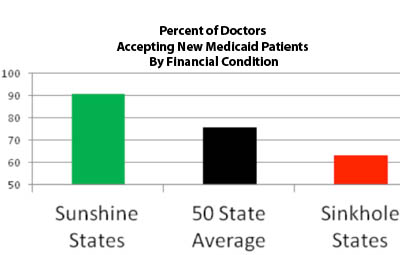Debt Loads Lower State Service Quality

Debt loads impair the ability of state governments to deliver promised services. The higher the debt load, the lower the willingness of doctors to accept new Medicaid patients.
In August 2012, Health Affairs magazine published a study of the share of doctors accepting new Medicaid patients. The study showed that doctors’ willingness to serve new Medicaid patients varied widely around the country. Doctors are less willing to serve new patients if the reimbursement rates are low relative to other forms of payment, and if state payments in Medicaid programs are slow.
There is a significant relationship between the IFTA Taxpayer Burden and this study’s measure of doctor willingness to serve new Medicaid patients. The relationship holds across the 50 states, and especially when looking more closely at IFTA’s “Sunshine” (low taxpayer burden) states and “Sinkhole” (high taxpayer burden) states.
The chart above shows the average percentage of doctors willing to take on new Medicaid patients in IFTA’s five “Sunshine” states (Alaska, Wyoming, North Dakota, Utah, and Nebraska), the average across the 50 states, and IFTA’s five “Sinkhole” states (Connecticut, New Jersey, Hawaii, Illinois, and Kentucky). The higher the debt load, the lower the willingness of doctors to accept new Medicaid patients. Conversely, states with lower debt loads appear better prepared to keep their promises.
More information on individual state financial conditions can be found by selecting a state on the map on the home page.
